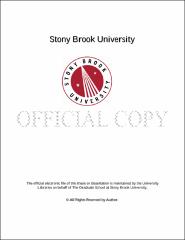| dc.identifier.uri | http://hdl.handle.net/11401/76999 | |
| dc.description.sponsorship | This work is sponsored by the Stony Brook University Graduate School in compliance with the requirements for completion of degree. | en_US |
| dc.format | Monograph | |
| dc.format.medium | Electronic Resource | en_US |
| dc.language.iso | en_US | |
| dc.publisher | The Graduate School, Stony Brook University: Stony Brook, NY. | |
| dc.type | Thesis | |
| dcterms.abstract | For as long as humans have incorporated stone into their material culture, they have used cooperative strategies (i.e., exchange networks) to mitigate the uneven distribution of available resources on the landscape. The procurement, transport, and selective distribution of lithic materials are thus uniquely human social institutions. One of the few ways to examine the limited evidence for this behavior in the archaeological record is through the geochemical characterization of artifacts and their potential source areas. Steatite vessels recovered on the outer coastal plain of Long Island, New York, are unique in that their acquisition required water-borne transportation from quarried geological deposits in Connecticut, Massachusetts, or Rhode Island. This research project employs techniques of material source characterization to examine the geographic context for steatite vessel exchange in a discrete study area, the Long Island Sound Watershed. Energy Dispersive X-Ray Fluorescence (EDXRF) was performed with a Bruker Tracer III-V hand-held/portable X-Ray Fluorescence (HHpXRF) unit on steatite artifacts from Long Island archaeological sites, in conjunction with samples collected from prehistoric steatite quarries, historic mines, and geological source areas. From these preliminary data, long-held assumptions about the structure of steatite utilization in Northeastern prehistory can begin to be addressed. Ultimately, this research attempts to establish what geological outcrops were the source(s) for the vessels found on Long Island, and what watershed corridors were the physical conduits for prehistoric trade. EDXRF data suggests that steatite vessels and smoking pipes transported to Eastern Long Island, New York came primarily from two source areas in Rhode Island: the Oaklawn and Ochee Springs quarries. | |
| dcterms.available | 2017-09-20T16:51:37Z | |
| dcterms.contributor | RASBURY, E. TROY | en_US |
| dcterms.contributor | SHEA, JOHN J | en_US |
| dcterms.contributor | VERSAGGI, NINA. | en_US |
| dcterms.creator | TWEEDIE, MARK STEPHENSON | |
| dcterms.dateAccepted | 2017-09-20T16:51:37Z | |
| dcterms.dateSubmitted | 2017-09-20T16:51:37Z | |
| dcterms.description | Department of Anthropology. | en_US |
| dcterms.extent | 183 pg. | en_US |
| dcterms.format | Application/PDF | en_US |
| dcterms.format | Monograph | |
| dcterms.identifier | http://hdl.handle.net/11401/76999 | |
| dcterms.issued | 2014-12-01 | |
| dcterms.language | en_US | |
| dcterms.provenance | Made available in DSpace on 2017-09-20T16:51:37Z (GMT). No. of bitstreams: 1
TWEEDIE_grad.sunysb_0771M_12205.pdf: 4629288 bytes, checksum: 00b02de3a912b8a9866941ae6e843051 (MD5)
Previous issue date: 1 | en |
| dcterms.publisher | The Graduate School, Stony Brook University: Stony Brook, NY. | |
| dcterms.subject | Archaeology | |
| dcterms.title | Exploratory Steatite Source Characterization in the Long Island Sound Watershed | |
| dcterms.type | Thesis | |

